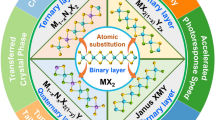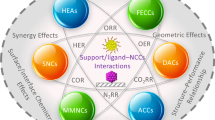Abstract
The design and fabrication of nanostructures based on titanium dioxide (TiO2) have attracted much attention because of their low cost, non-toxicity, stability, and potential applications in industry and technology. Recently, one-dimensional (1D) structured titanates have been used as titanium source to prepare TiO2 nanostructures with various crystalline phases, shapes, sizes, exposed facets, and hierarchical structures. Among the synthetic strategies, hydrothermal method is a facile route to controllable preparation of well-crystalline TiO2 in one step. Herein, we review our recent progress in transferring 1D titanates into TiO2 nanostructures through hydrothermal method, including the transformation mechanism and applications.
Similar content being viewed by others
References
Xia Y, Yang P, Sun Y, Wu Y, Mayers B, Gates B, Yin Y, Kim F. One-dimensional nanostructures: synthesis, characterization, and applications. Adv Mater, 2003, 15: 353–389
Jun Y-W, Choi J-S, Cheon J. Shape control of semiconductor and metal oxide nanocrystals through nonhydrolytic colloidal routes. Angew Chem Int Ed, 2006, 45: 3414–3439
Fujishima A, Honda K. Electrochemical photolysis of water at a semiconductor electrode. Nature, 1972, 238: 37–38
O’Regan B, Gratzel M. A low-cost, high-efficiency solar cell based on dye-sensitized colloidal TiO2 films. Nature, 1991, 353: 737–740
Chen X, Mao SS. Titanium dioxide nanomaterials: Synthesis, properties, modifications, and applications. Chem Rev, 2007, 107: 2891–2959
Liu G, Wang L, Yang HG, Cheng H-M, Lu GQ. Titania-based photocatalysts-crystal growth, doping and heterostructuring. J Mater Chem, 2010, 20: 831–843
Liu S, Yu J, Jaroniec M. Anatase TiO2 with dominant high-energy {001} facets: Synthesis, properties and applications. Chem Mater, 2011, 23: 4085–4093
Liu S, Li J, Shen Q, Cao Y, Guo X, Zhang G, Feng C, Zhang J, Liu Z, Steigerwald ML, Xu D, Nuckolls C. Mirror-image photoswitching of individual single-walled carbon nanotube transistors coated with titanium dioxide. Angew Chem Int Ed, 2009, 48: 4759–4762
Zhu H, Gao X, Lan Y, Song D, Xi Y, Zhao J. Hydrogen titanate nanofibers covered with anatase nanocrystals: A delicate structure achieved by the wet chemistry reaction of the titanate nanofibers. J Am Chem Soc, 2004, 126: 8380–8381
Zhu H, Lan Y, Gao X, Ringer S, Zheng Z, Song D, Zhao J. Phase transition between nanostructures of titanate and titanium dioxides via simple wet-chemical reactions. J Am Chem Soc, 2005, 127: 6730–6736
Yu Y, Xu D. Single-crystalline TiO2 nanorods: Highly active and easily recycled photocatalysts. Appl Catal B, 2007, 73: 166–171
Tsai CC, Teng HS. Structural features of nanotubes synthesized from NaOH treatment on TiO2 with different post-treatments. Chem Mater, 2006, 18: 367–373
Nian JN, Teng HS, Hydrothermal synthesis of single-crystalline anatase TiO2 nanorods with nanotubes as the precursor. J Phys Chem B, 2006, 110: 4193–4198
Du GH, Chen Q, Che RC, Yuan ZY, Peng LM. Preparation and structure analysis of titanium oxide nanotubes. Appl Phys Lett, 2001, 79: 3702–3704
Poudel B, Wang WZ, Dames C, Huang JY, Kunwar S, Wang DZ, Banerjee D, Chen G, Ren ZF. Formation of crystallized titania nanotubes and their transformation into nanowires. Nanotechnology, 2005, 16: 1935–1940
Armstrong AR, Armstrong G, Canales J, Bruce PG. TiO2-B nanowires. Angew Chem Int Ed, 2004, 43: 2286–2288
Kasuga T, Hiramatsu M, Hoson A, Sekino T, Niihara K. Formation of titanium oxide nanotube. Langmuir, 1998, 14: 3160–3163
Kasuga T, Hiramatsu M, Hoson A, Sekino T, Niihaha K. Titania nanotubes prepared by chemical processing. Adv Mater, 1999, 11: 1307–1311
Wu D, Liu J, Zhao XN, Li AD, Chen YF, Ming NB. Sequence of events for the formation of titanate nanotubes, nanofibers, nanowires, and nanobelts. Chem Mater, 2006, 18: 547–553
Morgan DL, Liu H-W, Frost RL, Waclawik ER. Implications of precursor chemistry on the alkaline hydrothermal synthesis of titania/titanate nanostructures. J Phys Chem C, 2010, 114: 101–110
Nakahira A, Kato W, Tamai M, Isshiki T, Nishio K. Synthesis of nanotube from a layered H2Ti4O9·H2O in a hydrothermal treatment using various titania sources. J Mater Sci, 2004, 39: 4239–4245
Ou H-H, Lo S-L. Review of titania nanotubes synthesized via the hydrothermal treatment: Fabrication, modification, and application. Sep Purif Technol, 2007, 58: 179–191
Bavykin DV, Walsh FC. Elongated titanate nanostructures and their applications. Eur J Inorg Chem, 2009, 977-997
Bavykin DV, Friedrich JM, Walsh FC. Protonated titanates and TiO2 nanostructured materials: Synthesis, properties, and applications. Adv Mater, 2006, 18: 2807–2824
Du G, Chen Q, Han P, Yu Y, Peng L-M. Potassium titanate nanowires: Structure, growth, and optical properties. Phys Rev B, 2003, 67: 035323
Wang R, Chen Q, Wang B, Zhang S, Peng L-M. Strain-induced formation of K2Ti6O13 nanowires via ion exchange. Appl Phys Lett, 2005, 86: 133101
Yang HG, Sun CH, Qiao SZ, Zou J, Liu G, Smith SC, Cheng HM, Lu GQ. Anatase TiO2 single crystals with a large percentage of reactive facets. Nature, 2008, 453: 638–641
Yang HG, Liu G, Qiao SZ, Sun CH, Jin YG, Smith SC, Zou J, Cheng HM, Lu GQ. Solvothermal synthesis and photoreactivity of anatase TiO2 nanosheets with dominant {001} facets. J Am Chem Soc, 2009, 131: 4078–4083
Han X, Kuang Q, Jin M, Xie Z, Zheng L. Synthesis of titania nanosheets with a high percentage of exposed (001) facets and related photocatalytic properties. J Am Chem Soc, 2009, 131: 3152–3153
Beltran A, Sambrano JR, Calatayud M, Sensato FR, Andres J. Static simulation of bulk and selected surfaces of anatase TiO2. Surf Sci, 2001, 490: 116–124
Calatayud M, Minot C. Effect of relaxation on structure and reactivity of anatase (100) and (001) surfaces. Surf Sci, 2004, 552: 169–179
Li J, Xu D. Tetragonal faceted-nanorods of anatase TiO2 single crystals with a large percentage of active {100} facets. Chem Commun, 2010, 46: 2301–2303
Li J, Cao K, Xu D. Tetragonal faceted-nanorods of anatase TiO2 with a large percentage of active {100} facets and their hierarchical structure. CrystEngComm, 2012, 14: 83–85
Li J, Yu Y, Chen Q, Li J, Xu D. Controllable synthesis of TiO2 single crystals with tunable shapes using ammonium-exchanged titanate nanowires as precursors. Cryst Growth Des, 2010, 10: 2111–2115
Amano F, Yasumoto T, Prieto-Mahaney O-O, Uchida S, Shibayama T, Ohtani B. Photocatalytic activity of octahedral single-crystalline mesoparticles of anatase titanium(IV) oxide. Chem Commun, 2009, 46: 2311–2313
Deng Q, Wei M, Ding X, Jiang L, Wei K, Zhou H. Large single-crystal anatase TiO2 bipyramids. J Cryst Growth, 2010, 312: 213–219
Han X, Wang X, Xie S, Kuang Q, Ouyang J, Xie Z, Zheng L. Carbonate ions-assisted syntheses of anatase TiO2 nanoparticles exposed with high energy (001) facets. RSC Adv, 2012, 2: 3251–3253
Bakardjieva S, Stengl V, Szatmary L, Subrt J, Lukac J, Murafa N, Niznansky D, Cizek K, Jirkovsky J, Petrova N. Transformation of brookite-type TiO2 nanocrystals to rutile: Correlation between microstructure and photoactivity. J Mater Chem, 2006, 16: 1709–1716
Marchand R, Brohan L, Tournoux M. TiO2(B) a new form of titanium dioxide and the potassium octatitanate K2Ti8O17. Mater Res Bull, 1980, 15: 1129–1133
Kawahara T, Konishi Y, Tada H, Tohge N, Nishii J, Ito S. A patterned TiO2(anatase)/TiO2(rutile) bilayer-type photocatalyst: Effect of the anatase/rutile junction on the photocatalytic activity. Angew Chem Int Ed, 2002, 41: 2811–2813
Zhang J, Xu Q, Feng Z, Li M, Li C. Importance of the relationship between surface phases and photocatalytic activity of TiO2. Angew Chem Int Ed, 2008, 47: 1766–1769
Li J, Yang H, Li Q, Xu D. Enlarging the application of potassium titanate nanowires as titanium source for preparation of TiO2 nanostructures with tunable phases. CrystEngComm, DOI: 10.1039/c2ce06672f
Bruce PG, Scrosati B, Tarascon J-M. Nanomaterials for rechargeable lithium batteries. Angew Chem Int Ed, 2008, 47: 2930–2946
Li J, Wan W, Zhou H, Li J, Xu D. Hydrothermal synthesis of TiO2(B) nanowires with ultrahigh surface area and their fast charging and discharging properties in Li-ion batteries. Chem Commun, 2011, (47): 3439–3441
Lijima S. Helical microtubules of graphitic carbon. Nature, 1991, 354: 56–58
Nalwa HS. Handbook of Nanostructured Materials and Nanotechnology. Academic Press, 2000
Klabunde KJ. Nanoscale Materials in Chemistry. John Wiley & Sons, Inc, 2001
Wang ZL. Nanowires and Nanobelts: Materials, Properties and Devices. Kluwer Press, 2003
Wu X-J, Zhu F, Mu C, Liang Y, Xu L, Chen Q, Chen R, Xu D. Electrochemical synthesis and applications of oriented and hierarchically quasi-1D semiconducting nanostructures. Coord Chem Rev, 2010, 254: 1135–1150
Armstrong G, Armstrong AR, Canales J, Bruce PG. Nanotubes with the TiO2-B structure. Chem Commun, 2005, 41: 2454–2456
Mao Y, Wong SS. Size- and shape-dependent transformation of nanosized titanate into analogous anatase titania nanostructures. J Am Chem Soc, 2006, 128: 8217–8226
Yang D, Liu H, Zheng Z, Yuan Y, Zhao J-C, Waclawik ER, Ke X, Zhu H. An efficient photocatalyst structure: TiO2(B) nanofibers with a shell of anatase nanocrystals. J Am Chem Soc, 2009, 131: 17885–17893
Yang P, Deng T, Zhao D, Feng P, Pine D, Chmelka BF, Whitesides GM, Stucky GD. Hierarchically ordered oxides. Science, 1998, 282: 2244–2246
Miao Z, Xu D, Ouyang J, Guo G, Zhao X, Tang Y. Electrochemically induced sol-gel preparation of single-crystalline TiO2 nanowires. Nano Lett, 2002, 2: 717–720
Chen Q, Xu D. Large-scale, noncurling, and free-standing crystallized TiO2 nanotube arrays for dye-sensitized solar cells. J Phys Chem C, 2009, 113: 6310–6314
Yang W-G, Wan F-R, Chen Q-W, Li J-J, Xu D-S. Controlling synthesis of well-crystallized mesoporous TiO2 microspheres with ultrahigh surface area for high-performance dye-sensitized solar cells. J Mater Chem, 2010, 20: 2870–2876
Chen JS, Tan YL, Li CM, Cheah YL, Luan D, Madhavi S, Boey FYC, Archer LA, Lou XW. Constructing hierarchical spheres from large ultrathin anatase TiO2 nanosheets with nearly 100% exposed (001) facets for fast reversible lithium storage. J Am Chem Soc, 2010, 132: 6124–6130
Yang W, Li J, Wang Y, Zhu F, Shi W, Wan F. Xu D. A facile synthesis of anatase TiO2 nanosheets-based hierarchical spheres with over 90% {001} facets for dye-sensitized solar cells. Chem Commun, 2011, (47): 1809–1811
Li J, Wan W, Zhu F, Li Q, Zhou H, Li J, Xu D. Nanotube-based hierarchical titanate microspheres: An improved anode structure for Li-ion batteries. Chem Commun, 2012, (48): 389–391
Clarke JB, Hastie JW, Kihlborg LHE, Metselaar R, Thackeray MM. Definitions of terms relating to phase transitions of the solid state. Pure & Appl Chem, 1994, 66: 577–594
Barnard AS, Zapol P, Curtiss LA. Anatase and rutile surfaces with adsorbates representative of acidic and basic conditions. Surf Sci, 2005, 582: 173–188
Barnard AS, Curtiss LA. Prediction of TiO2 nanoparticle phase and shape transitions controlled by surface chemistry. Nano Lett, 2005, 5: 1261–1266
Hirakawa T, Nosaka Y. Properties of O ·−2 and OH· formed in TiO2 aqueous suspensions by photocatalytic reaction and the influence of H2O2 and some ions. Langmuir, 2002, 18: 3247–3254
Hurum DC, Agrios AG, Gray KA, Rajh T, Thurnauer MC. Explaining the enhanced photocatalytic activity of degussa P25 mixed-phase TiO2 using EPR. J Phys Chem B, 2003, 107: 4545–4549
Yang Z, Choi D, Kerisit S, Rosso KM, Wang D, Zhang J, Graff G, Liu J. Nanostructures and lithium electrochemical reactivity of lithium titanites and titanium oxides: A review. J Power Sources, 2009, 192: 588–598
Arico AS, Bruce P, Scrosati B, Tarascon J-M, Schalkwijc WV. Nanostructured materials for advanced energy conversion and storage devices. Nat Mater, 2005, 4: 366–377
Panduwinata D, Gale JD. A first principles investigation of lithium intercalation in TiO2-B. J Mater Chem, 2009, 19: 3931–3940
Arrouvel C, Parker SC, Islam MS. Lithium insertion and transport in the TiO2-B anode material: a computational study. Chem Mater, 2009, 21: 4778–4783
Guo Y-G, Hu J-S, Wan L-J. Nanostructured materials for electrochemical energy conversion and storage devices. Adv Mater, 2008, 20: 2878–2887
Wang G, Wang Q, Lu W, Li J. Photoelectrochemical study on charge transfer properties of TiO2-B nanowires with an application as humidity sensors. J Phys Chem B, 2006, 110: 22029–22034
Author information
Authors and Affiliations
Corresponding authors
Rights and permissions
About this article
Cite this article
Xu, D., Li, J., Yu, Y. et al. From titanates to TiO2 nanostructures: Controllable synthesis, growth mechanism, and applications. Sci. China Chem. 55, 2334–2345 (2012). https://doi.org/10.1007/s11426-012-4674-y
Received:
Accepted:
Published:
Issue Date:
DOI: https://doi.org/10.1007/s11426-012-4674-y




